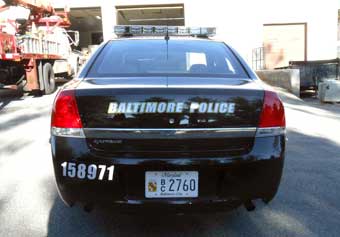Last fall, the Baltimore City Police Department made plans to add sixty-three new Chevrolet Caprices to its patrol line-up. They also took this opportunity to change the stripes and decals they had been using on their existing vehicles to match the styles that were being employed on their Foxtrot helicopters.
To do this, they turned to the sign company that has long been serving their design and graphics needs for nearly sixty-five years, Shannon Baum Signs & Graphics.
“The new design for their police cars was a bit of a challenge because the layout of the new stripes was diagonal, whereas the existing stripes they had been employing were straight,” says Denise Baum, vice-president of Shannon-Baum Signs.
Shannon-Baum Signs & Graphics is a family-owned, full-service sign shop in Eldersburg, Maryland that is celebrating its sixty-fifth year in business. (Note: See sidebar on opposite page.) Denise’s grandfather first started work with the police department back in 1954. “They didn’t have wraps back then,” explains Denise. “Instead they used vehicle lettering. They had to cut the reflective by hand.”
Today the stripes and decals are cut by Shannon-Baum from 3M reflective material and a paper pattern via the company’s array of four Roland plotters.
The Baltimore Police Department had been using the same decals on their cars for the past twenty years. But last year, the department’s fleet supervisor contacted Shannon-Baum about this stylistic changeover and requested a concept drawing of a prototype vehicle using this design. “We produced the drawing via Illustrator and emailed them the PDFs,” says Denise. “We received approval within a few days.”
The fleet manager and public relations supervisor then presented this initial drawing to the board for approval. Shannon-Baum also provided drawings and color samples and met with Baltimore city officials to make sure they had all of the right components to fabricate a quality look for the decals.
“The City of Baltimore allowed us to make a few modifications during the design phase and were open to suggestions and recommendations,” says Denise. “A few minor changes were made once we applied a paper mock-up to the prototype vehicle to make sure the designs correctly matched.”
Eventually the purchase order was issued to supply all the materials required to mark thirty-three black cars and thirty white 2015 Chevrolet Caprice police patrol vehicles with stripes and decals. “The design is the same for both the black cars and the white cars,” says Denise. “The only difference is the unit numbers. They’re black on the white vehicles and blue with a yellow outline on the black vehicles.”

Shannon-Baum released the first prototype vehicle for approval, and within two weeks, minor changes were made and a final approved layout was signed.
The City of Baltimore provided the color samples for the decals and stripes. With these in hand, Shannon-Baum printed the decals and stripes via its Roland SOLJET onto 3M 680CR-10 reflective with 3M 8519 lustre overlaminate. They used 15 rolls of 48-inch-by-50-yard material.
Marking police vehicles is a little different than lettering personal or commercial vehicles, because graphics applied to emergency vehicles are required to be reflective. “However since the stripes and decals on the Foxtrot helicopters were painted, the colors we printed on the reflective material are slightly different,” says Denise, “but are as close as possible.”
The Baltimore City Police Department picked up the first set of decals and stripes and installed them onto their new set of vehicles. (Note: Shannon-Baum only installed the prototype vehicles decals and stripes, in order to help them with the final design.)
“Since the vehicles did not arrive all at once, we were able to spread out the shipment of decals to twelve sets every two weeks,” says Denise.
By Jeff Wooten
All photos: Shannon Baum Signs & Graphics











